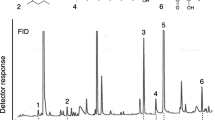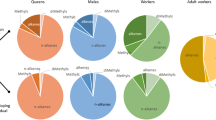Summary.
In this paper we report on the chemical basis for trail recognition in Lasius nipponensis. On and near trails in the field, workers became aggressive against conspecific intruders and succeeded in protective contests, while intruders usually avoided confrontation. Such asymmetric interactions were also observed in the laboratory when two non-nestmate workers were sequentially placed in a clean glass dish, while mutual aggression was observed when they were placed simultaneously. Asymmetric aggression was also observed when the workers were placed in a dish previously conditioned by other workers, or when the dish was treated with the hexane rinse of the conditioned dish. The rinse contained a series of hydrocarbons, in which components and proportion were almost identical to those of the cuticular hydrocarbons of the workers, except for a lack of n-alkanes. Amounts of the hydrocarbons that remained on the dish were very small when all the tarsi of the workers were incapacitated. We therefore consider that the hydrocarbons are not adhesion of the cuticular hydrocarbons but secretion from the tarsi of workers, and serve as a key signal for trail recognition in this ant.
Similar content being viewed by others
Author information
Authors and Affiliations
Corresponding author
Rights and permissions
About this article
Cite this article
Akino, T., Morimoto, M. & Yamaoka, R. The chemical basis for trail recognition in Lasius nipponensis (Hymenoptera: Formicidae). Chemoecology 15, 13–20 (2005). https://doi.org/10.1007/s00049-005-0287-7
Received:
Accepted:
Issue Date:
DOI: https://doi.org/10.1007/s00049-005-0287-7




